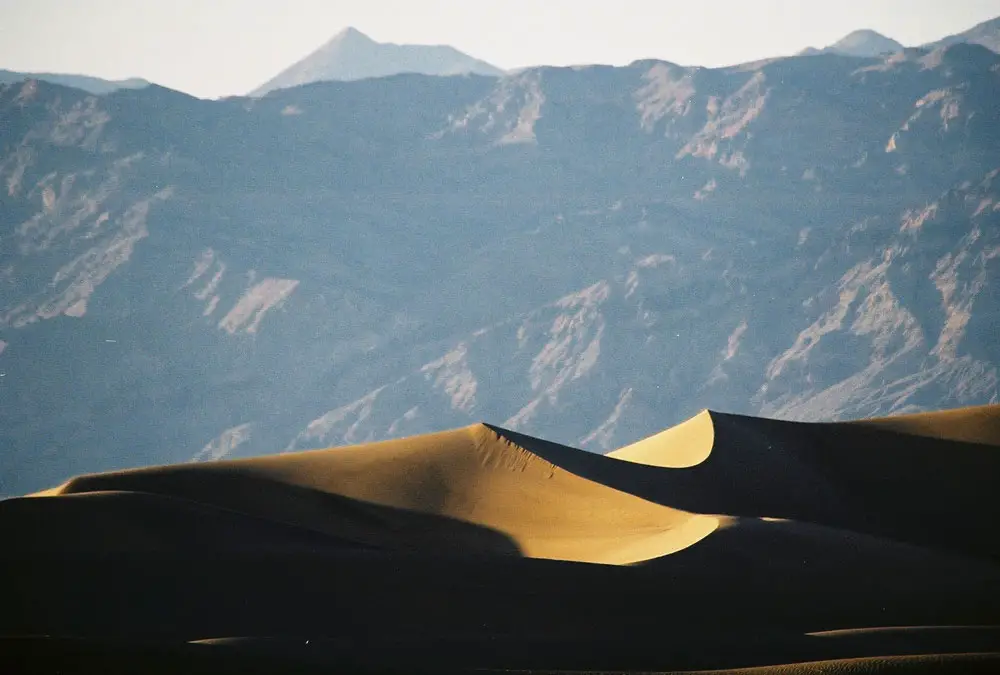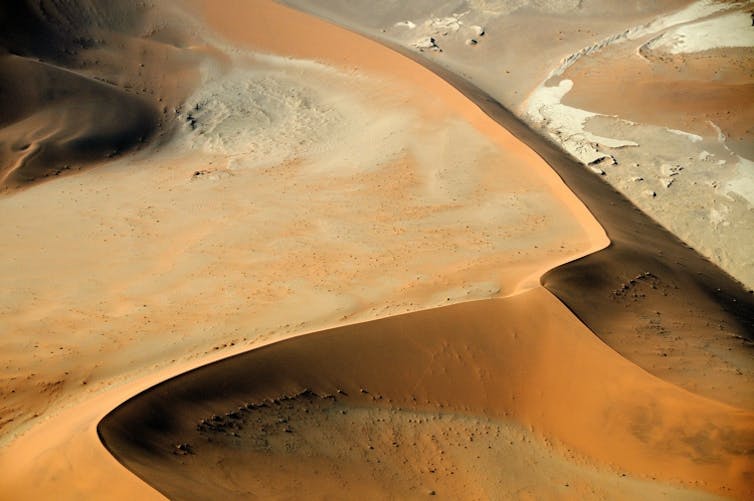
By David Thomas
The Dune films remind us of just how beautiful, mysterious, expansive and changeable sand dunes can be. For centuries these wonderful landforms have filled humans with awe – and in some cases fear and foreboding – because of the apparent remoteness and risks associated with the deserts they are synonymous with.
That’s what first attracted me to research deserts and dunes more than 40 years ago, and I have been investigating them ever since. Here are five things I have learned that may surprise you:
Not all dunes are made of sand
Ash, snow and even gypsum can all build dunes. Dunes develop when small particles are mobilised on bare dry surfaces by a moderate wind, accumulating where movement is slowed down by an obstacle or a surface undulation. Where the wind deposits the particles they can create a small mound against which other particles in turn accumulate, leading eventually to a dune.
“Sand” is not really a material – it is a size of particle, somewhere between 0.06mm and 2mm diameter. Dunes in deserts and at the coast are primarily formed of quartz and feldspar grains, the most common minerals on earth.
But in volcanic regions, such as the interior of Iceland, dunes can be formed of ash, while in the centre of Antarctica, the driest and windiest continental earth, dunes can form from ice crystals and snow. In New Mexico, US, the very soft and bright mineral gypsum forms dunes – appropriately the place is called White Sands.
Dunes can record a history of climate changes
Sand dunes might seem soft and changeable, but below their active surface there often lies older sand that tells a story of long-term development.
Dune shape is affected by how changeable wind direction is through the year: some dunes, such as crescent-shaped barchan dunes, roll forward under fairly consistent winds, with the sand turning over on a regular basis. Others, such as linear and star dunes, develop where wind directions are more variable, piling sand up to thicknesses of tens and even hundreds of metres.

Christophe André / flickr, CC BY-NC-SA
Using a technique called luminescence dating, we can measure how long dune sand has been hidden from sunlight, identifying periods when dunes even stopped forming and soils, now themselves buried under more sand, developed on dune surfaces under wetter climates.
In Arabia’s Rub’ al Khali desert, for example, giant linear sand dunes have formed in several dry periods during the past 130,000 years. The dunes may even be much older, as it hasn’t yet been possible to drill all the way through to the base and establish the whole accumulation history.
Only a fifth of deserts are covered by sand dunes
Only about a fifth of all desert areas have the right conditions to form dunes: a supply of fine loose sediment, enough wind energy and the absence of protective vegetation. Other common desert landscape features include mountains, rock slopes, gravel surfaces and dry lake beds.
Yet we can go beyond today’s deserts and find evidence of more widespread dune landscapes, for example underneath the grass and woodlands of some of Africa‘s savanna regions such as the Kalahari and even under tropical rainforests in parts of South America. These dunes testify to different patterns of deserts and climate in the past.
Scotland’s ancient dunes changed history
In the 1780s, the Scottish geologist James Hutton realised that the well-bedded and distinctive red sandstones at Siccar Point on Scotland’s eastern coast were in fact the preserved remains of ancient desert sand dunes. At this location the Devonian old red sandstone, as it is now known, abruptly overlies fine grey mudstones.
Hutton realised that a considerable period of time – we now know it to be over 65 million years – must have elapsed between the grey rocks being laid down, smoothed flat by erosion, and the red sands being deposited on top.
His careful theorising established the foundations of modern geology and our understanding that the earth was much older than the history that had been calculated from biblical texts. Further developments in the 20th century enabled us to explain why rocks formed under desert conditions are found in the unlikely context of Scotland – we now know it’s due to movements of the earth’s crust, or plate tectonics.
Coastal dunes defend against storms
Sand dunes fringe large tracts of the world’s coastlines, built from wind-blown sand derived from the drying intertidal beach zone and trapped by onshore vegetation. While only 7% of the British coastline has dunes, 40% of Australia’s and 60% of Portugal’s are fronted by dunes.
These dunes play a vital role in protecting low-lying land from tidal surges and storms. Yet in some areas human recreation and sand extraction for building has degraded the dunes by damaging stabilising vegetation and creating blow-outs, with sea level rise adding a further risk.
![]()
David Thomas is Professor of Geography at the University of Oxford.





























Leave a Reply